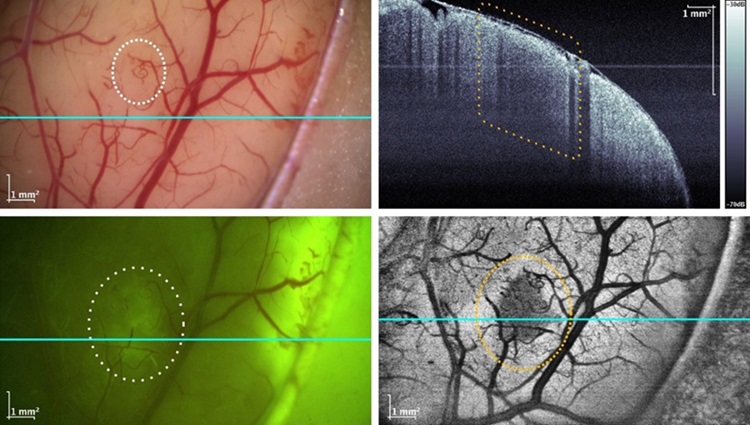Fast OCT System Integrated into Neurosurgical Microscope Identifies Tumor Margins During Brain Surgery
Posted on 04 Oct 2024
Optical coherence tomography (OCT) is a non-invasive imaging method that generates high-resolution, cross-sectional images of tissue, enabling the visualization of structures beneath the surface. While this technology is widely used in fields like ophthalmology and cardiology, most commercially available OCT systems can only capture around 30 two-dimensional (2D) images per second. Researchers have now made a significant advancement by integrating a megahertz-speed OCT (MHz-OCT) system into a standard neurosurgical microscope, demonstrating its clinical value. This marks an important step toward creating an OCT device capable of identifying tumor margins during brain surgery.
Researchers at the University of Lübeck (Lübeck, Germany) have been working to enhance the speed of OCT technology by improving its light sources, sensors, and developing software to manage the large amounts of data generated. Their efforts led to the creation of an integrated MHz-OCT system that can be used during surgery to produce high-quality volumetric OCT cross-sectional images within seconds, with the scans immediately available for post-processing. As detailed in the journal Biomedical Optics Express, the MHz-OCT system can achieve over one million depth scans per second. This incredible imaging speed is enabled by the incorporation of a Fourier domain mode locking laser, a concept originally developed by the researchers in 2005. Additionally, advances in graphics processing unit (GPU) technology over the last 15 years have provided the computational power necessary to process raw OCT signals into readable images without requiring a bulky computer setup.

To evaluate whether their MHz-OCT system could help identify brain tumor margins, the researchers integrated it with a specialized microscope that surgeons use for enhanced visualization during brain surgery. After successfully building the system, they tested it on calibration targets and tissue analog phantoms. Once these tests proved successful, they moved on to patient safety testing and eventually launched a clinical study involving 30 patients undergoing brain tumor resection surgery. During the study, the researchers collected about 10 terabytes of OCT imaging data, which was matched with corresponding pathological histology information. They found that the system fit seamlessly into the operating room's regular workflow and exceeded their expectations in terms of image quality.
Despite these promising results, the researchers acknowledge they are in the early stages of understanding the data and images produced by the new system. They are currently developing AI methods to classify the tissue, which will take time to refine. As a result, it may still be several years before this technology is widely adopted for brain tumor resection surgeries. Additionally, the research team is preparing a new study to use the system in demonstrating the precise location of brain activity in response to external stimuli during neurosurgery. This could enhance the accuracy of neuroprosthetic electrode implantation, enabling better control of prosthetic devices by connecting them to the brain’s electrical signals.
“We see our microscope integrated MHz-OCT system being used not just in brain tumor surgeries, but as a tool in every neurosurgery setting, since it can acquire high contrast pictures of anatomy such as blood vessels through the thick membrane that surrounds the brain,” said Wolfgang Draxinger from University of Lübeck. “This could significantly improve outcomes for procedures requiring detailed information about anatomical structures beneath the brain’s surface, such as deep brain stimulation for Parkinson’s disease.”














